Stainless steel countertops are a popular choice for kitchens due to their durability, sleek appearance, and resistance to staining and heat. However, keeping them clean and spotless requires proper care and attention. Regular maintenance not only preserves their shiny finish but also ensures hygiene in food preparation areas.
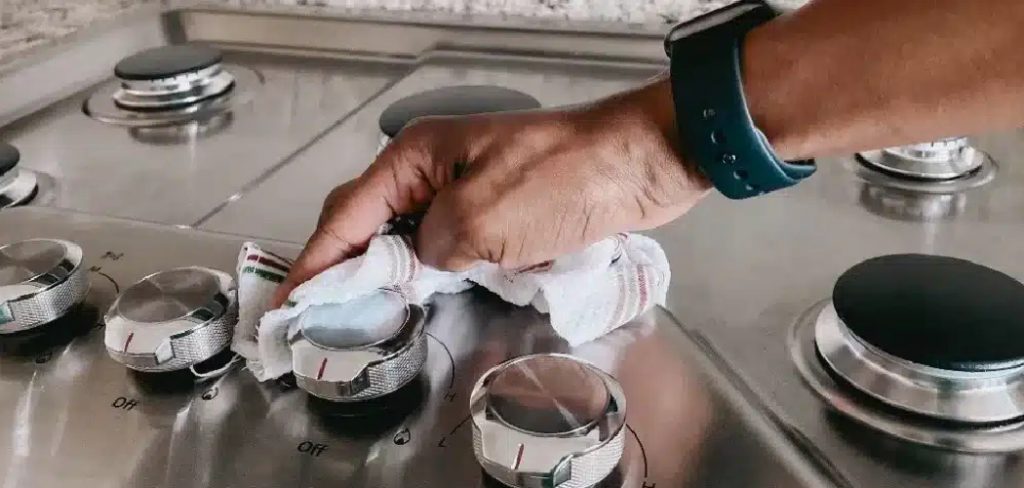
This guide on how to clean stainless steel countertop will walk you through effective methods to clean and maintain your stainless steel countertop, helping it look its best for years to come.
Why is It Important to Clean Stainless Steel Countertops?
Cleaning your stainless steel countertop is important for several reasons. Firstly, stainless steel is prone to water spots and fingerprints, which can make it look dull and unattractive. Regular cleaning prevents the buildup of residue, grease, and grime that can also affect its appearance.
Moreover, due to its use in food preparation areas, maintaining a clean surface is crucial for hygiene purposes. Stainless steel is a non-porous material, making it resistant to bacteria and germs. However, regular cleaning ensures that any potential contaminants are removed from its surface.
Materials Needed for Cleaning
Before we dive into the methods of cleaning, here is a list of materials you will need:
Microfiber Cloth or Soft Sponge
Avoid using abrasive cloths or sponges as they can scratch the surface of your stainless steel countertop.
Mild Dish Soap
Choose a mild dish soap that is free from harsh chemicals and abrasives, as they can damage the finish of your countertop.
Vinegar
Vinegar is an effective natural cleaner for stainless steel. It helps remove water spots and stains, leaving a streak-free shine.
Baking Soda
Baking soda is another natural cleaning agent that works well on stainless steel surfaces. It can help remove tough stains and grease buildup without damaging the surface.
Mineral Oil
Mineral oil or other specialized stainless steel cleaners can be used for extra shine and protection.
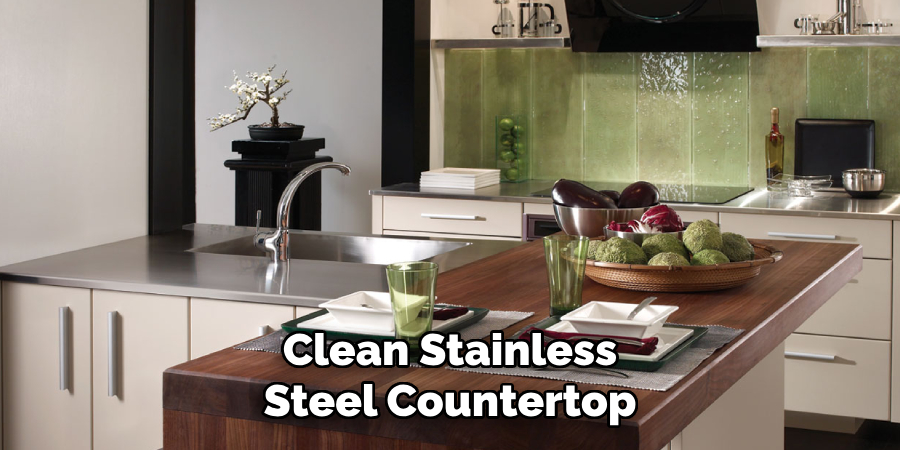
7 Step-by-step Methods on How to Clean Stainless Steel Countertop
Method 1: Mild Soap and Water Solution
- Prepare a solution of warm water and mild dish soap in a bowl.
- Dip a microfiber cloth or soft sponge into the solution, wring out excess water, and gently wipe the countertop surface.
- For tougher stains, let the solution sit for a few minutes before wiping it off.
- Rinse the cloth or sponge with clean water and wipe off any soap residue from the countertop.
- Dry the surface with a clean microfiber cloth to prevent water spots.
Method 2: Vinegar Solution
- In a spray bottle, mix equal parts of vinegar and water.
- Spray the solution onto the countertop surface and let it sit for a few minutes.
- Wipe off the solution with a microfiber cloth, following the grain of your stainless steel.
- If there are any stubborn stains, you can make a paste of baking soda and water and gently scrub the area with a soft sponge or cloth.
- Rinse off any residue with clean water and dry the surface with a clean cloth.
Method 3: Baking Soda Paste
- Mix equal parts of baking soda and water to make a paste.
- Apply the paste onto the stain or grease buildup on your countertop.
- Let it sit for 10-15 minutes before gently scrubbing it off with a soft sponge or cloth.
- Rinse off any residue with clean water and dry the surface with a clean cloth.
Method 4: Mineral Oil
- Apply a few drops of mineral oil onto a clean cloth.
- Gently rub the oil onto the surface of your stainless steel countertop, following the grain.
- Continue rubbing until you achieve the desired shine and remove any water spots or fingerprints.
Method 5: Club Soda
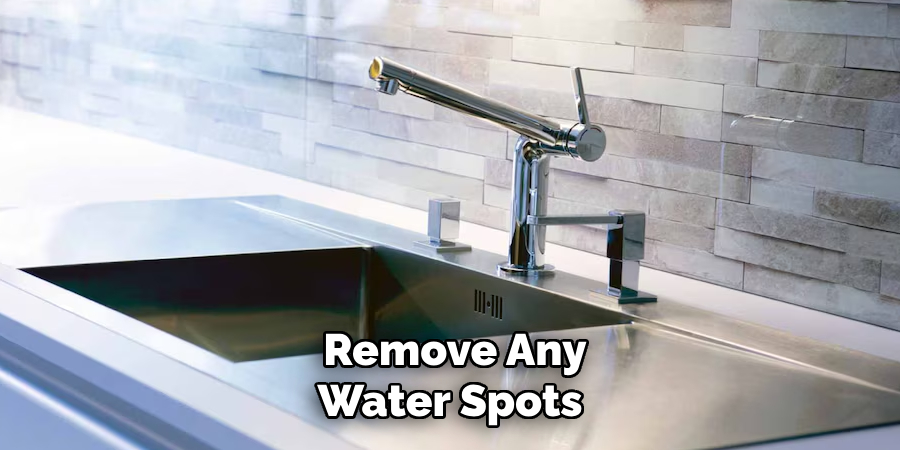
- Pour some club soda onto a soft sponge or cloth.
- Gently scrub the surface of your countertop in circular motions to remove any buildup or stains.
- Rinse off with clean water and dry with a clean cloth.
Method 6: Commercial Stainless Steel Cleaner
- Follow the instructions on the cleaner’s label for best results.
- Apply it onto the surface of your countertop and let it sit for a few minutes.
- Wipe it off with a clean microfiber cloth, following the grain of your stainless steel.
- Rinse off any residue with clean water and dry the surface with a clean cloth.
Method 7: Steam Cleaning
- Use a steam cleaner specifically designed for use on stainless steel surfaces.
- Follow the instructions on the cleaner’s label for best results.
- Ensure that you wipe the surface dry after using the steam cleaner to prevent water spots from forming.
- For tougher stains, you can use a combination of steam cleaning and one of the above methods.
Following these methods on how to clean stainless steel countertop will help you keep your stainless steel countertop clean and in pristine condition. It is recommended to clean your countertop regularly with mild soap and water, and use the other methods as needed for tougher stains or buildup. Remember to always dry the surface after cleaning to prevent water spots from forming.
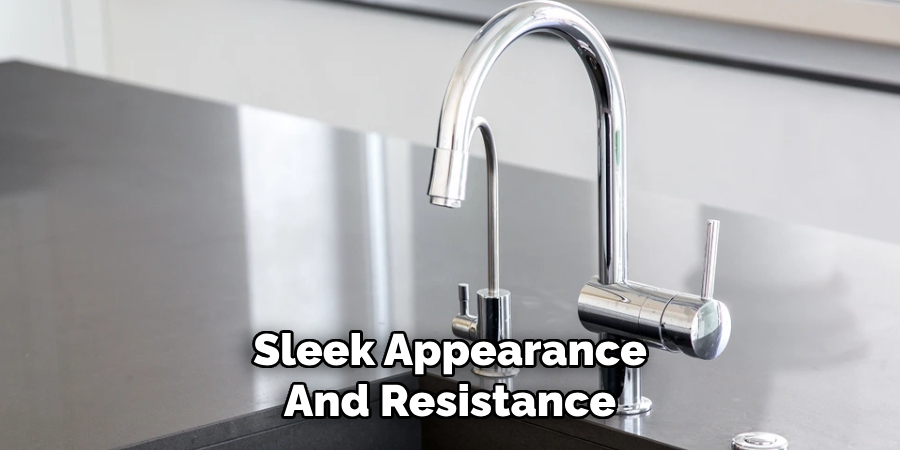
Do You Need to Use Professionals?
While the cleaning methods described above are simple enough to handle on your own, there are times when hiring professionals can be beneficial.
If your stainless steel countertop has extensive scratches, significant discoloration, or stubborn stains that regular cleaning methods fail to resolve, professional cleaning or refinishing services may be necessary. Professionals have access to specialized tools and products that can restore the original look and luster of your countertop without causing additional damage.
Additionally, if you have a busy lifestyle or prefer to ensure your countertop receives top-notch care, professionals can save you time and effort. They can also provide valuable advice on maintaining your stainless steel surfaces in the long term. Ultimately, while regular cleaning can be done effectively at home, professional help is a great option for addressing severe issues or achieving a flawless finish.
Tips for Maintaining Your Stainless Steel Countertop
- Clean up spills and stains immediately to prevent them from setting in or causing damage to your countertop.
- Avoid using abrasive cleaners, steel wool, or harsh chemicals on your stainless steel countertop as they can scratch the surface and damage the finish.
- Always wipe in the direction of the grain to prevent any potential scratching.
- Use a cutting board or protective mat when sharp objects are on your countertop to prevent scratches.
- Avoid leaving wet items or standing water on your countertop for extended periods as it can cause water spots or discoloration.
By following these cleaning and maintenance tips, you can keep your stainless steel countertop looking shiny and new for years to come.
Frequently Asked Questions
Q: How Often Should I Clean My Stainless Steel Countertop?
A: It is recommended to clean your countertop regularly with mild soap and water, and use the other methods as needed for tougher stains or buildup.
Q: Can I Use Bleach or Other Harsh Chemicals to Clean My Stainless Steel Countertop?
A: No, it is not recommended to use bleach or harsh chemicals on your stainless steel countertop as they can damage the finish and potentially cause discoloration. Stick to mild dish soap, vinegar, baking soda, or specialized stainless steel cleaners for best results.
Q: How Can I Remove Rust from My Stainless Steel Countertop?
A: Mix a solution of equal parts lemon juice and baking soda to make a paste. Apply the paste onto the rust stain and let it sit for 10-15 minutes before scrubbing it off with a soft sponge or cloth. Rinse off any residue with clean water and dry the surface with a clean cloth.
Q: Can I Use Steel Wool to Clean My Stainless Steel Countertop?
A: No, it is not recommended to use steel wool on your stainless steel countertop as it can scratch the surface and damage the finish. Stick to soft cloths or sponges for cleaning. End your document with a call to action, encouraging readers to try out the methods discussed in the content and share their experiences.
Q: Are There Any Natural Alternatives for Cleaning Stainless Steel Countertops?
A: Yes, you can use a lemon and salt solution or vinegar and olive oil mixture to clean your stainless steel countertop. These natural ingredients can effectively remove stains and add shine to your surface without using harsh chemicals. Give them a try and see the results for yourself! Don’t forget to share your experience with us.
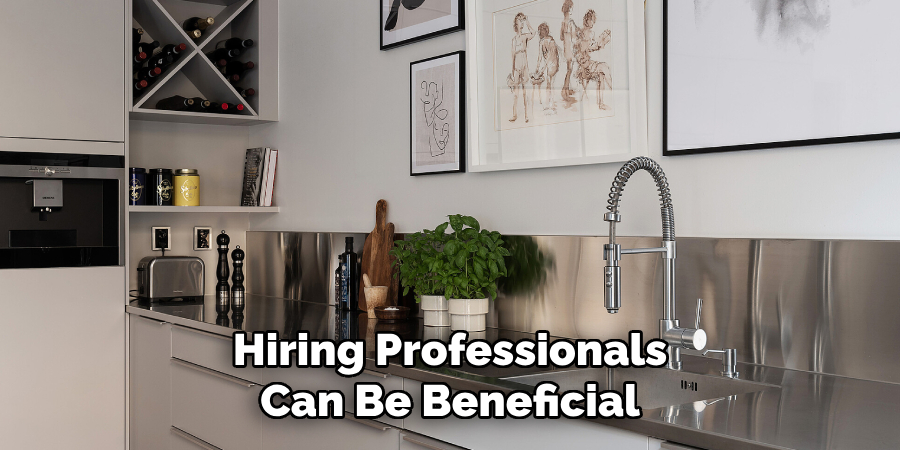
Conclusion
Maintaining a stainless steel countertop doesn’t have to be a daunting task. With the right cleaning methods and regular care, you can keep your countertop looking sleek and polished for years to come. From using natural alternatives like vinegar and baking soda to investing in commercial cleaners or professional services when needed, there are plenty of options to meet your specific needs.
By following the tips and advice on how to clean stainless steel countertop provided, you can protect your stainless steel surface from damage, ensure its longevity, and enjoy the timeless elegance it brings to your space. Try out these methods today and share your success stories—we’d love to hear how they worked for you!
Professional Focus
Angela Ervin, a former interior designer turned blogger, specializes in kitchen design and renovations. Through her website, she blends her passion for cooking with design expertise, sharing practical and creative ideas. Known for balancing functionality and beauty, Angela’s insightful content has made her a trusted voice in home design and lifestyle.
About the Author
Angela Ervin, an experienced interior designer and blogger, combines her passion for kitchen renovations with storytelling. Living in Petersburg with her family, she enjoys cooking and testing her projects firsthand. Known for her humor and relatable style, Angela shares creative, functional design insights through her content, making her a trusted voice in home design.
Education History
University: Virginia Commonwealth University
Degree: Bachelor of Fine Arts (BFA) in Interior Design
- Angela’s education at VCU focused on mastering core interior design principles, including spatial planning, color theory, materials selection, and sustainable design practices.
- She gained hands-on experience through studio projects and collaborative design exercises, which honed her ability to create functional and aesthetically pleasing environments.
- Her coursework also emphasized problem-solving and practical applications of design, preparing her for real-world projects like her self-directed kitchen renovations.
- The program’s strong foundation in both technical skills and creative expression shaped Angela’s ability to seamlessly integrate form and function in her work.
